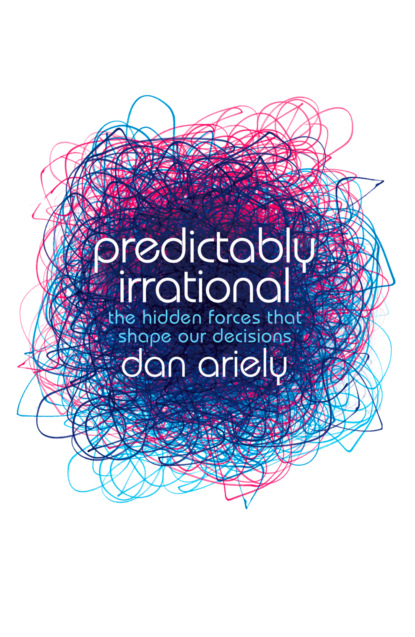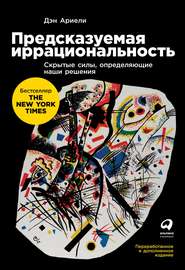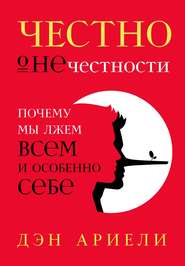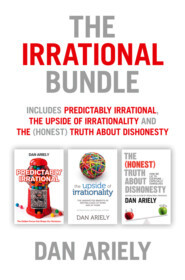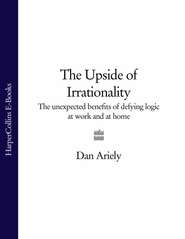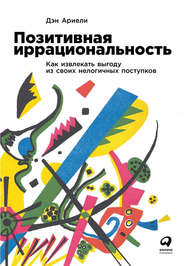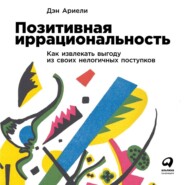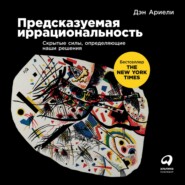По всем вопросам обращайтесь на: info@litportal.ru
(©) 2003-2024.
✖
Predictably Irrational
Автор
Год написания книги
2018
Настройки чтения
Размер шрифта
Высота строк
Поля
BUT THIS WAS only the start of our exploration. We also wanted to know how influential the anchor would be in future decisions. Suppose we gave the participants an opportunity to drop this anchor and run for another? Would they do it? To put it in terms of goslings, would they swim across the pond after their original imprint and then, midway, swing their allegiance to a new mother goose? In terms of goslings, I think you know that they would stick with the original mom. But what about humans? The next two phases of the experiment would enable us to answer these questions.
In the second phase of the experiment, we took participants from the previous 10-cents and 90-cents groups and treated them to 30 seconds of a white, wooshing noise. “Hypothetically, would you listen to this sound again for 50 cents?” we asked them at the end. The respondents pressed a button on their computers to indicate yes or no.
“OK, how much would you need to be paid for this?” we asked. Our participants typed in their lowest price; the computer did its thing; and, depending on their bids, some participants listened to the sound again and got paid and some did not. When we compared the prices, the 10-cents group offered much lower bids than the 90-cents group. This means that although both groups had been equally exposed to the suggested 50 cents, as their focal anchoring response (to “Hypothetically, would you listen to this sound again for 50 cents?”), the first anchor in this annoying sound category (which was 10 cents for some and 90 cents for others) predominated.
Why? Perhaps the participants in the 10-cents group said something like the following to themselves: “Well, I listened previously to that annoying sound for a low amount. This sound is not much different. So if I said a low amount for the previous one, I guess I could bear this sound for about the same price.” Those who were in the 90-cents group used the same type of logic, but because their starting point was different, so was their ending point. These individuals told themselves, “Well, I listened previously to that annoying sound for a high amount. This sound is not much different. So since I said a high amount for the previous one, I guess I could bear this sound for about the same price.” Indeed, the effect of the first anchor held – indicating that anchors have an enduring effect for present prices as well as for future prices.
There was one more step to this experiment. This time we had our participants listen to the oscillating sound that rose and fell in pitch for 30 seconds. We asked our 10-cents group, “Hypothetically, would you listen to this sound again for 90 cents?” Then we asked our 90-cents group, “Would you listen to this sound again for 10 cents?” Having flipped our anchors, we would now see which one, the local anchor or the first anchor, exerted the greatest influence.
Once again, the participants typed in yes or no. Then we asked them for real bids: “How much would it take for you to listen to this again?” At this point, they had a history with three anchors: the first one they encountered in the experiment (either 10 cents or 90 cents), the second one (50 cents), and the most recent one (either 90 cents or 10 cents). Which one of these would have the largest influence on the price they demanded to listen to the sound?
Again, it was as if our participants' minds told them, “If I listened to the first sound for x cents, and listened to the second sound for x cents as well, then I can surely do this one for x cents, too!” And that's what they did. Those who had first encountered the 10-cent anchor accepted low prices, even after 90 cents was suggested as the anchor. On the other hand, those who had first encountered the 90-cent anchor kept on demanding much higher prices, regardless of the anchors that followed.
What did we show? That our first decisions resonate over a long sequence of decisions. First impressions are important, whether they involve remembering that our first DVD player cost much more than such players cost today (and realizing that, in comparison, the current prices are a steal) or remembering that gas was once a dollar a gallon, which makes every trip to the gas station a painful experience. In all these cases the random, and not so random, anchors that we encountered along the way and were swayed by remain with us long after the initial decision itself.
NOW THAT WE know we behave like goslings, it is important to understand the process by which our first decisions translate into long-term habits. To illustrate this process, consider this example. You're walking past a restaurant, and you see two people standing in line, waiting to get in. “This must be a good restaurant,” you think to yourself. “People are standing in line.” So you stand behind these people. Another person walks by. He sees three people standing in line and thinks, “This must be a fantastic restaurant,” and joins the line. Others join. We call this type of behavior herding. It happens when we assume that something is good (or bad) on the basis of other people's previous behavior, and our own actions follow suit.
But there's also another kind of herding, one that we call self-herding. This happens when we believe something is good (or bad) on the basis of our own previous behavior. Essentially, once we become the first person in line at the restaurant, we begin to line up behind ourself in subsequent experiences. Does that make sense? Let me explain.
Recall your first introduction to Starbucks, perhaps several years ago. (I assume that nearly everyone has had this experience, since Starbucks sits on every corner in America.) You are sleepy and in desperate need of a liquid energy boost as you embark on an errand one afternoon. You glance through the windows at Starbucks and walk in. The prices of the coffee are a shock – you've been blissfully drinking the brew at Dunkin' Donuts for years. But since you have walked in and are now curious about what coffee at this price might taste like, you surprise yourself: you buy a small coffee, enjoy its taste and its effect on you, and walk out.
The following week you walk by Starbucks again. Should you go in? The ideal decision-making process should take into account the quality of the coffee (Starbucks versus Dunkin' Donuts); the prices at the two places; and, of course, the cost (or value) of walking a few more blocks to get to Dunkin' Donuts. This is a complex computation – so instead, you resort to the simple approach: “I went to Starbucks before, and I enjoyed myself and the coffee, so this must be a good decision for me.” So you walk in and get another small cup of coffee.
In doing so, you just became the second person in line, standing behind yourself. A few days later, you again walk by Starbucks and this time, you vividly remember your past decisions and act on them again – voilà! You become the third person in line, standing behind yourself. As the weeks pass, you enter again and again and every time, you feel more strongly that you are acting on the basis of your preferences. Buying coffee at Starbucks has become a habit with you.
BUT THE STORY doesn't end there. Now that you have gotten used to paying more for coffee, and have bumped yourself up onto a new curve of consumption, other changes also become simpler. Perhaps you will now move up from the small cup for $2.20 to the medium size for $3.50 or to the Vend for $4.15. Even though you don't know how you got into this price bracket in the first place, moving to a larger coffee at a relatively greater price seems pretty logical. So is a lateral move to other offerings at Starbucks: Caffè Americano, Caffè Misto, Macchiato, and Frappuccino, for instance.
If you stopped to think about this, it would not be clear whether you should be spending all this money on coffee at Starbucks instead of getting cheaper coffee at Dunkin' Do-nuts or even free coffee at the office. But you don't think about these trade-offs anymore. You've already made this decision many times in the past, so you now assume that this is the way you want to spend your money. You've herded yourself – lining up behind your initial experience at Starbucks – and now you're part of the crowd.
HOWEVER, THERE IS something odd in this story. If anchoring is based on our initial decisions, how did Starbucks manage to become an initial decision in the first place? In other words, if we were previously anchored to the prices at Dunkin' Donuts, how did we move our anchor to Starbucks? This is where it gets really interesting.
When Howard Shultz created Starbucks, he was as intuitive a businessman as Salvador Assael. He worked diligently to separate Starbucks from other coffee shops, not through price but through ambience. Accordingly, he designed Starbucks from the very beginning to feel like a continental coffeehouse.
The early shops were fragrant with the smell of roasted beans (and better-quality roasted beans than those at Dunkin' Donuts). They sold fancy French coffee presses. The showcases presented alluring snacks – almond croissants, biscotti, raspberry custard pastries, and others. Whereas Dunkin' Donuts had small, medium, and large coffees, Starbucks offered Short, Tall, Grande, and Venti, as well as drinks with high-pedigree names like Caffè Americano, Caffè Misto, Macchiato, and Frappuccino. Starbucks did everything in its power, in other words, to make the experience feel different – so different that we would not use the prices at Dunkin' Donuts as an anchor, but instead would be open to the new anchor that Starbucks was preparing for us. And that, to a great extent, is how Starbucks succeeded.
GEORGE, DRAZEN, AND I were so excited with the experiments on coherent arbitrariness that we decided to push the idea one step farther. This time, we had a different twist to explore.
Do you remember the famous episode in The Adventures of Tom Sawyer, the one in which Tom turned the whitewashing of Aunt Polly's fence into an exercise in manipulating his friends? As I'm sure you recall, Tom applied the paint with gusto, pretending to enjoy the job. “Do you call this work?” Tom told his friends. “Does a boy get a chance to whitewash a fence every day?” Armed with this new “information,” his friends discovered the joys of whitewashing a fence. Before long, Tom's friends were not only paying him for the privilege, but deriving real pleasure from the task – a win-win outcome if there ever was one.
From our perspective, Tom transformed a negative experience to a positive one – he transformed a situation in which compensation was required to one in which people (Tom's friends) would pay to get in on the fun. Could we do the same? We thought we'd give it a try.
One day, to the surprise of my students, I opened the day's lecture on managerial psychology with a poetry selection, a few lines of “Whoever you are holding me now in hand” from Walt Whitman's Leaves of Grass:
Whoever you are holding me now in hand,
Without one thing all will be useless,
I give you fair warning before you attempt me further,
I am not what you supposed, but far different.
Who is he that would become my follower?
Who would sign himself a candidate for my affections?
The way is suspicious, the result uncertain, perhaps destructive,
You would have to give up all else, I alone would expect to be your sole and exclusive standard,
Your novitiate would even then be long and exhausting,
The whole past theory of your life and all conformity to the lives around you would have to be abandon'd,
Therefore release me now before troubling yourself any further, let go your hand from my shoulders,
Put me down and depart on your way.
After closing the book, I told the students that I would be conducting three readings from Walt Whitman's Leaves of Grass that Friday evening: one short, one medium, and one long. Owing to limited space, I told them, I had decided to hold an auction to determine who could attend. I passed out sheets of paper so that they could bid for a space; but before they did so, I had a question to ask them.
I asked half the students to write down whether, hypothetically, they would be willing to pay me $10 for a 10-minute poetry recitation. I asked the other half to write down whether, hypothetically, they would be willing to listen to me recite poetry for ten minutes if I paid them $10.
This, of course, served as the anchor. Now I asked the students to bid for a spot at my poetry reading. Do you think the initial anchor influenced the ensuing bids?
Before I tell you, consider two things. First, my skills at reading poetry are not of the first order. So asking someone to pay me for 10 minutes of it could be considered a stretch. Second, even though I asked half of the students if they would pay me for the privilege of attending the recitation, they didn't have to bid that way. They could have turned the tables completely and demanded that I pay them.
And now to the results (drumroll, please). Those who answered the hypothetical question about paying me were indeed willing to pay me for the privilege. They offered, on average, to pay me about a dollar for the short poetry reading, about two dollars for the medium poetry reading, and a bit more than three dollars for the long poetry reading. (Maybe I could make a living outside academe after all.)
But, what about those who were anchored to the thought of being paid (rather than paying me)? As you might expect, they demanded payment: on average, they wanted $1.30 to listen to the short poetry reading, $2.70 to listen to the medium poetry reading, and $4.80 to endure the long poetry reading.
Much like Tom Sawyer, then, I was able to take an ambiguous experience (and if you could hear me recite poetry, you would understand just how ambiguous this experience is) and arbitrarily make it into a pleasurable or painful experience. Neither group of students knew whether my poetry reading was of the quality that is worth paying for or of the quality that is worth listening to only if one is being financially compensated for the experience (they did not know if it is pleasurable or painful). But once the first impression had been formed (that they would pay me or that I would pay them), the die was cast and the anchor set. Moreover, once the first decision had been made, other decisions followed in what seemed to be a logical and coherent manner. The students did not know whether listening to me recite poetry was a good or bad experience, but whatever their first decision was, they used it as input for their subsequent decisions and provided a coherent pattern of responses across the three poetry readings.
Of course, Mark Twain came to the same conclusions: “If Tom had been a great and wise philosopher, like the writer of this book, he would now have comprehended that work consists of whatever a body is obliged to do, and that play consists of whatever a body is not obliged to do.” Mark Twain further observed: “There are wealthy gentlemen in England who drive four-horse passenger-coaches twenty or thirty miles on a daily line in the summer because the privilege costs them considerable money; but if they were offered wages for the service, that would turn it into work, and then they would resign.”[8 - We will return to this astute observation in the chapter on social and market norms (Chapter 4).]
WHERE DO THESE thoughts lead us? For one, they illustrate the many choices we make, from the trivial to the profound, in which anchoring plays a role. We decide whether or not to purchase Big Macs, smoke, run red lights, take vacations in Patagonia, listen to Tchaikovsky, slave away at doctoral dissertations, marry, have children, live in the suburbs, vote Republican, and so on. According to economic theory, we base these decisions on our fundamental values – our likes and dislikes.
But what are the main lessons from these experiments about our lives in general? Could it be that the lives we have so carefully crafted are largely just a product of arbitrary coherence? Could it be that we made arbitrary decisions at some point in the past (like the goslings that adopted Lorenz as their parent) and have built our lives on them ever since, assuming that the original decisions were wise? Is that how we chose our careers, our spouses, the clothes we wear, and the way we style our hair? Were they smart decisions in the first place? Or were they partially random first imprints that have run wild?
Descartes said, Cogito ergo sum—“I think, therefore I am.” But suppose we are nothing more than the sum of our first, naive, random behaviors. What then?
These questions may be tough nuts to crack, but in terms of our personal lives, we can actively improve on our irrational behaviors. We can start by becoming aware of our vulnerabilities. Suppose you're planning to buy a cutting-edge cell phone (the one with the three-megapixel, 8× zoom digital camera), or even a daily $4 cup of gourmet coffee. You might begin by questioning that habit. How did it begin? Second, ask yourself what amount of pleasure you will be getting out of it. Is the pleasure as much as you thought you would get? Could you cut back a little and better spend the remaining money on something else? With everything you do, in fact, you should train yourself to question your repeated behaviors. In the case of the cell phone, could you take a step back from the cutting edge, reduce your outlay, and use some of the money for something else? And as for the coffee – rather than asking which blend of coffee you will have today, ask yourself whether you should even be having that habitual cup of expensive coffee at all.[9 - I am not claiming that spending money on a wonderful cup of coffee every day, or even a few times a day, is necessarily a bad decision – I am saying only that we should question our decisions.]
We should also pay particular attention to the first decision we make in what is going to be a long stream of decisions (about clothing, food, etc.). When we face such a decision, it might seem to us that this is just one decision, without large consequences; but in fact the power of the first decision can have such a long-lasting effect that it will percolate into our future decisions for years to come. Given this effect, the first decision is crucial, and we should give it an appropriate amount of attention.
Socrates said that the unexamined life is not worth living. Perhaps it's time to inventory the imprints and anchors in our own life. Even if they once were completely reasonable, are they still reasonable? Once the old choices are reconsidered, we can open ourselves to new decisions – and the new opportunities of a new day. That seems to make sense.
ALL THIS TALK about anchors and goslings has larger implications than consumer preferences, however. Traditional economics assumes that prices of products in the market are determined by a balance between two forces: production at each price (supply) and the desires of those with purchasing power at each price (demand). The price at which these two forces meet determines the prices in the marketplace.
This is an elegant idea, but it depends centrally on the assumption that the two forces are independent and that together they produce the market price. The results of all the experiments presented in this chapter (and the basic idea of arbitrary coherence itself) challenge these assumptions. First, according to the standard economic framework, consumers' willingness to pay is one of the two inputs that determine market prices (this is the demand). But as our experiments demonstrate, what consumers are willing to pay can easily be manipulated, and this means that consumers don't in fact have a good handle on their own preferences and the prices they are willing to pay for different goods and experiences.
Second, whereas the standard economic framework assumes that the forces of supply and demand are independent, the type of anchoring manipulations we have shown here suggest that they are, in fact, dependent. In the real world, anchoring comes from manufacturer's suggested retail prices (MSRPs), advertised prices, promotions, product introductions, etc. – all of which are supply-side variables. It seems then that instead of consumers' willingness to pay influencing market prices, the causality is somewhat reversed and it is market prices themselves that influence consumers' willingness to pay. What this means is that demand is not, in fact, a completely separate force from supply.
AND THIS IS not the end of the story. In the framework of arbitrary coherence, the relationships we see in the marketplace between demand and supply (for example, buying more yogurt when it is discounted) are based not on preferences but on memory. Here is an illustration of this idea. Consider your current consumption of milk and wine. Now imagine that two new taxes will be introduced tomorrow. One will cut the price of wine by 50 percent, and the other will increase the price of milk by 100 percent. What do you think will happen? These price changes will surely affect consumption, and many people will walk around slightly happier and with less calcium. But now imagine this. What if the new taxes are accompanied by induced amnesia for the previous prices of wine and milk? What if the prices change in the same way, but you do not remember what you paid for these two products in the past?
I suspect that the price changes would make a huge impact on demand if people remembered the previous prices and noticed the price increases; but I also suspect that without a memory for past prices, these price changes would have a trivial effect, if any, on demand. If people had no memory of past prices, the consumption of milk and wine would remain essentially the same, as if the prices had not changed. In other words, the sensitivity we show to price changes might in fact be largely a result of our memory for the prices we have paid in the past and our desire for coherence with our past decisions – not at all a reflection of our true preferences or our level of demand.
The same basic principle would also apply if the government one day decided to impose a tax that doubled the price of gasoline. Under conventional economic theory, this should cut demand. But would it? Certainly, people would initially compare the new prices with their anchor, would be flabbergasted by the new prices, and so might pull back on their gasoline consumption and maybe even get a hybrid car. But over the long run, and once consumers readjusted to the new price and the new anchors (just as we adjust to the price of Nike sneakers, bottled water, and everything else), our gasoline consumption, at the new price, might in fact get close to the pretax level. Moreover, much as in the example of Starbucks, this process of readjustment could be accelerated if the price change were to also be accompanied by other changes, such as a new grade of gas, or a new type of fuel (such as corn-based ethanol fuel).
I am not suggesting that doubling the price of gasoline would have no effect on consumers' demand. But I do believe that in the long term, it would have a much smaller influence on demand than would be assumed from just observing the short-term market reactions to price increases.
ANOTHER IMPLICATION OF arbitrary coherence has to do with the claimed benefits of the free market and free trade. The basic idea of the free market is that if I have something that you value more than I do – let's say a sofa – trading this item will benefit both of us. This means that the mutual benefit of trading rests on the assumption that all the players in the market know the value of what they have and the value of the things they are considering getting from the trade.
In the second phase of the experiment, we took participants from the previous 10-cents and 90-cents groups and treated them to 30 seconds of a white, wooshing noise. “Hypothetically, would you listen to this sound again for 50 cents?” we asked them at the end. The respondents pressed a button on their computers to indicate yes or no.
“OK, how much would you need to be paid for this?” we asked. Our participants typed in their lowest price; the computer did its thing; and, depending on their bids, some participants listened to the sound again and got paid and some did not. When we compared the prices, the 10-cents group offered much lower bids than the 90-cents group. This means that although both groups had been equally exposed to the suggested 50 cents, as their focal anchoring response (to “Hypothetically, would you listen to this sound again for 50 cents?”), the first anchor in this annoying sound category (which was 10 cents for some and 90 cents for others) predominated.
Why? Perhaps the participants in the 10-cents group said something like the following to themselves: “Well, I listened previously to that annoying sound for a low amount. This sound is not much different. So if I said a low amount for the previous one, I guess I could bear this sound for about the same price.” Those who were in the 90-cents group used the same type of logic, but because their starting point was different, so was their ending point. These individuals told themselves, “Well, I listened previously to that annoying sound for a high amount. This sound is not much different. So since I said a high amount for the previous one, I guess I could bear this sound for about the same price.” Indeed, the effect of the first anchor held – indicating that anchors have an enduring effect for present prices as well as for future prices.
There was one more step to this experiment. This time we had our participants listen to the oscillating sound that rose and fell in pitch for 30 seconds. We asked our 10-cents group, “Hypothetically, would you listen to this sound again for 90 cents?” Then we asked our 90-cents group, “Would you listen to this sound again for 10 cents?” Having flipped our anchors, we would now see which one, the local anchor or the first anchor, exerted the greatest influence.
Once again, the participants typed in yes or no. Then we asked them for real bids: “How much would it take for you to listen to this again?” At this point, they had a history with three anchors: the first one they encountered in the experiment (either 10 cents or 90 cents), the second one (50 cents), and the most recent one (either 90 cents or 10 cents). Which one of these would have the largest influence on the price they demanded to listen to the sound?
Again, it was as if our participants' minds told them, “If I listened to the first sound for x cents, and listened to the second sound for x cents as well, then I can surely do this one for x cents, too!” And that's what they did. Those who had first encountered the 10-cent anchor accepted low prices, even after 90 cents was suggested as the anchor. On the other hand, those who had first encountered the 90-cent anchor kept on demanding much higher prices, regardless of the anchors that followed.
What did we show? That our first decisions resonate over a long sequence of decisions. First impressions are important, whether they involve remembering that our first DVD player cost much more than such players cost today (and realizing that, in comparison, the current prices are a steal) or remembering that gas was once a dollar a gallon, which makes every trip to the gas station a painful experience. In all these cases the random, and not so random, anchors that we encountered along the way and were swayed by remain with us long after the initial decision itself.
NOW THAT WE know we behave like goslings, it is important to understand the process by which our first decisions translate into long-term habits. To illustrate this process, consider this example. You're walking past a restaurant, and you see two people standing in line, waiting to get in. “This must be a good restaurant,” you think to yourself. “People are standing in line.” So you stand behind these people. Another person walks by. He sees three people standing in line and thinks, “This must be a fantastic restaurant,” and joins the line. Others join. We call this type of behavior herding. It happens when we assume that something is good (or bad) on the basis of other people's previous behavior, and our own actions follow suit.
But there's also another kind of herding, one that we call self-herding. This happens when we believe something is good (or bad) on the basis of our own previous behavior. Essentially, once we become the first person in line at the restaurant, we begin to line up behind ourself in subsequent experiences. Does that make sense? Let me explain.
Recall your first introduction to Starbucks, perhaps several years ago. (I assume that nearly everyone has had this experience, since Starbucks sits on every corner in America.) You are sleepy and in desperate need of a liquid energy boost as you embark on an errand one afternoon. You glance through the windows at Starbucks and walk in. The prices of the coffee are a shock – you've been blissfully drinking the brew at Dunkin' Donuts for years. But since you have walked in and are now curious about what coffee at this price might taste like, you surprise yourself: you buy a small coffee, enjoy its taste and its effect on you, and walk out.
The following week you walk by Starbucks again. Should you go in? The ideal decision-making process should take into account the quality of the coffee (Starbucks versus Dunkin' Donuts); the prices at the two places; and, of course, the cost (or value) of walking a few more blocks to get to Dunkin' Donuts. This is a complex computation – so instead, you resort to the simple approach: “I went to Starbucks before, and I enjoyed myself and the coffee, so this must be a good decision for me.” So you walk in and get another small cup of coffee.
In doing so, you just became the second person in line, standing behind yourself. A few days later, you again walk by Starbucks and this time, you vividly remember your past decisions and act on them again – voilà! You become the third person in line, standing behind yourself. As the weeks pass, you enter again and again and every time, you feel more strongly that you are acting on the basis of your preferences. Buying coffee at Starbucks has become a habit with you.
BUT THE STORY doesn't end there. Now that you have gotten used to paying more for coffee, and have bumped yourself up onto a new curve of consumption, other changes also become simpler. Perhaps you will now move up from the small cup for $2.20 to the medium size for $3.50 or to the Vend for $4.15. Even though you don't know how you got into this price bracket in the first place, moving to a larger coffee at a relatively greater price seems pretty logical. So is a lateral move to other offerings at Starbucks: Caffè Americano, Caffè Misto, Macchiato, and Frappuccino, for instance.
If you stopped to think about this, it would not be clear whether you should be spending all this money on coffee at Starbucks instead of getting cheaper coffee at Dunkin' Do-nuts or even free coffee at the office. But you don't think about these trade-offs anymore. You've already made this decision many times in the past, so you now assume that this is the way you want to spend your money. You've herded yourself – lining up behind your initial experience at Starbucks – and now you're part of the crowd.
HOWEVER, THERE IS something odd in this story. If anchoring is based on our initial decisions, how did Starbucks manage to become an initial decision in the first place? In other words, if we were previously anchored to the prices at Dunkin' Donuts, how did we move our anchor to Starbucks? This is where it gets really interesting.
When Howard Shultz created Starbucks, he was as intuitive a businessman as Salvador Assael. He worked diligently to separate Starbucks from other coffee shops, not through price but through ambience. Accordingly, he designed Starbucks from the very beginning to feel like a continental coffeehouse.
The early shops were fragrant with the smell of roasted beans (and better-quality roasted beans than those at Dunkin' Donuts). They sold fancy French coffee presses. The showcases presented alluring snacks – almond croissants, biscotti, raspberry custard pastries, and others. Whereas Dunkin' Donuts had small, medium, and large coffees, Starbucks offered Short, Tall, Grande, and Venti, as well as drinks with high-pedigree names like Caffè Americano, Caffè Misto, Macchiato, and Frappuccino. Starbucks did everything in its power, in other words, to make the experience feel different – so different that we would not use the prices at Dunkin' Donuts as an anchor, but instead would be open to the new anchor that Starbucks was preparing for us. And that, to a great extent, is how Starbucks succeeded.
GEORGE, DRAZEN, AND I were so excited with the experiments on coherent arbitrariness that we decided to push the idea one step farther. This time, we had a different twist to explore.
Do you remember the famous episode in The Adventures of Tom Sawyer, the one in which Tom turned the whitewashing of Aunt Polly's fence into an exercise in manipulating his friends? As I'm sure you recall, Tom applied the paint with gusto, pretending to enjoy the job. “Do you call this work?” Tom told his friends. “Does a boy get a chance to whitewash a fence every day?” Armed with this new “information,” his friends discovered the joys of whitewashing a fence. Before long, Tom's friends were not only paying him for the privilege, but deriving real pleasure from the task – a win-win outcome if there ever was one.
From our perspective, Tom transformed a negative experience to a positive one – he transformed a situation in which compensation was required to one in which people (Tom's friends) would pay to get in on the fun. Could we do the same? We thought we'd give it a try.
One day, to the surprise of my students, I opened the day's lecture on managerial psychology with a poetry selection, a few lines of “Whoever you are holding me now in hand” from Walt Whitman's Leaves of Grass:
Whoever you are holding me now in hand,
Without one thing all will be useless,
I give you fair warning before you attempt me further,
I am not what you supposed, but far different.
Who is he that would become my follower?
Who would sign himself a candidate for my affections?
The way is suspicious, the result uncertain, perhaps destructive,
You would have to give up all else, I alone would expect to be your sole and exclusive standard,
Your novitiate would even then be long and exhausting,
The whole past theory of your life and all conformity to the lives around you would have to be abandon'd,
Therefore release me now before troubling yourself any further, let go your hand from my shoulders,
Put me down and depart on your way.
After closing the book, I told the students that I would be conducting three readings from Walt Whitman's Leaves of Grass that Friday evening: one short, one medium, and one long. Owing to limited space, I told them, I had decided to hold an auction to determine who could attend. I passed out sheets of paper so that they could bid for a space; but before they did so, I had a question to ask them.
I asked half the students to write down whether, hypothetically, they would be willing to pay me $10 for a 10-minute poetry recitation. I asked the other half to write down whether, hypothetically, they would be willing to listen to me recite poetry for ten minutes if I paid them $10.
This, of course, served as the anchor. Now I asked the students to bid for a spot at my poetry reading. Do you think the initial anchor influenced the ensuing bids?
Before I tell you, consider two things. First, my skills at reading poetry are not of the first order. So asking someone to pay me for 10 minutes of it could be considered a stretch. Second, even though I asked half of the students if they would pay me for the privilege of attending the recitation, they didn't have to bid that way. They could have turned the tables completely and demanded that I pay them.
And now to the results (drumroll, please). Those who answered the hypothetical question about paying me were indeed willing to pay me for the privilege. They offered, on average, to pay me about a dollar for the short poetry reading, about two dollars for the medium poetry reading, and a bit more than three dollars for the long poetry reading. (Maybe I could make a living outside academe after all.)
But, what about those who were anchored to the thought of being paid (rather than paying me)? As you might expect, they demanded payment: on average, they wanted $1.30 to listen to the short poetry reading, $2.70 to listen to the medium poetry reading, and $4.80 to endure the long poetry reading.
Much like Tom Sawyer, then, I was able to take an ambiguous experience (and if you could hear me recite poetry, you would understand just how ambiguous this experience is) and arbitrarily make it into a pleasurable or painful experience. Neither group of students knew whether my poetry reading was of the quality that is worth paying for or of the quality that is worth listening to only if one is being financially compensated for the experience (they did not know if it is pleasurable or painful). But once the first impression had been formed (that they would pay me or that I would pay them), the die was cast and the anchor set. Moreover, once the first decision had been made, other decisions followed in what seemed to be a logical and coherent manner. The students did not know whether listening to me recite poetry was a good or bad experience, but whatever their first decision was, they used it as input for their subsequent decisions and provided a coherent pattern of responses across the three poetry readings.
Of course, Mark Twain came to the same conclusions: “If Tom had been a great and wise philosopher, like the writer of this book, he would now have comprehended that work consists of whatever a body is obliged to do, and that play consists of whatever a body is not obliged to do.” Mark Twain further observed: “There are wealthy gentlemen in England who drive four-horse passenger-coaches twenty or thirty miles on a daily line in the summer because the privilege costs them considerable money; but if they were offered wages for the service, that would turn it into work, and then they would resign.”[8 - We will return to this astute observation in the chapter on social and market norms (Chapter 4).]
WHERE DO THESE thoughts lead us? For one, they illustrate the many choices we make, from the trivial to the profound, in which anchoring plays a role. We decide whether or not to purchase Big Macs, smoke, run red lights, take vacations in Patagonia, listen to Tchaikovsky, slave away at doctoral dissertations, marry, have children, live in the suburbs, vote Republican, and so on. According to economic theory, we base these decisions on our fundamental values – our likes and dislikes.
But what are the main lessons from these experiments about our lives in general? Could it be that the lives we have so carefully crafted are largely just a product of arbitrary coherence? Could it be that we made arbitrary decisions at some point in the past (like the goslings that adopted Lorenz as their parent) and have built our lives on them ever since, assuming that the original decisions were wise? Is that how we chose our careers, our spouses, the clothes we wear, and the way we style our hair? Were they smart decisions in the first place? Or were they partially random first imprints that have run wild?
Descartes said, Cogito ergo sum—“I think, therefore I am.” But suppose we are nothing more than the sum of our first, naive, random behaviors. What then?
These questions may be tough nuts to crack, but in terms of our personal lives, we can actively improve on our irrational behaviors. We can start by becoming aware of our vulnerabilities. Suppose you're planning to buy a cutting-edge cell phone (the one with the three-megapixel, 8× zoom digital camera), or even a daily $4 cup of gourmet coffee. You might begin by questioning that habit. How did it begin? Second, ask yourself what amount of pleasure you will be getting out of it. Is the pleasure as much as you thought you would get? Could you cut back a little and better spend the remaining money on something else? With everything you do, in fact, you should train yourself to question your repeated behaviors. In the case of the cell phone, could you take a step back from the cutting edge, reduce your outlay, and use some of the money for something else? And as for the coffee – rather than asking which blend of coffee you will have today, ask yourself whether you should even be having that habitual cup of expensive coffee at all.[9 - I am not claiming that spending money on a wonderful cup of coffee every day, or even a few times a day, is necessarily a bad decision – I am saying only that we should question our decisions.]
We should also pay particular attention to the first decision we make in what is going to be a long stream of decisions (about clothing, food, etc.). When we face such a decision, it might seem to us that this is just one decision, without large consequences; but in fact the power of the first decision can have such a long-lasting effect that it will percolate into our future decisions for years to come. Given this effect, the first decision is crucial, and we should give it an appropriate amount of attention.
Socrates said that the unexamined life is not worth living. Perhaps it's time to inventory the imprints and anchors in our own life. Even if they once were completely reasonable, are they still reasonable? Once the old choices are reconsidered, we can open ourselves to new decisions – and the new opportunities of a new day. That seems to make sense.
ALL THIS TALK about anchors and goslings has larger implications than consumer preferences, however. Traditional economics assumes that prices of products in the market are determined by a balance between two forces: production at each price (supply) and the desires of those with purchasing power at each price (demand). The price at which these two forces meet determines the prices in the marketplace.
This is an elegant idea, but it depends centrally on the assumption that the two forces are independent and that together they produce the market price. The results of all the experiments presented in this chapter (and the basic idea of arbitrary coherence itself) challenge these assumptions. First, according to the standard economic framework, consumers' willingness to pay is one of the two inputs that determine market prices (this is the demand). But as our experiments demonstrate, what consumers are willing to pay can easily be manipulated, and this means that consumers don't in fact have a good handle on their own preferences and the prices they are willing to pay for different goods and experiences.
Second, whereas the standard economic framework assumes that the forces of supply and demand are independent, the type of anchoring manipulations we have shown here suggest that they are, in fact, dependent. In the real world, anchoring comes from manufacturer's suggested retail prices (MSRPs), advertised prices, promotions, product introductions, etc. – all of which are supply-side variables. It seems then that instead of consumers' willingness to pay influencing market prices, the causality is somewhat reversed and it is market prices themselves that influence consumers' willingness to pay. What this means is that demand is not, in fact, a completely separate force from supply.
AND THIS IS not the end of the story. In the framework of arbitrary coherence, the relationships we see in the marketplace between demand and supply (for example, buying more yogurt when it is discounted) are based not on preferences but on memory. Here is an illustration of this idea. Consider your current consumption of milk and wine. Now imagine that two new taxes will be introduced tomorrow. One will cut the price of wine by 50 percent, and the other will increase the price of milk by 100 percent. What do you think will happen? These price changes will surely affect consumption, and many people will walk around slightly happier and with less calcium. But now imagine this. What if the new taxes are accompanied by induced amnesia for the previous prices of wine and milk? What if the prices change in the same way, but you do not remember what you paid for these two products in the past?
I suspect that the price changes would make a huge impact on demand if people remembered the previous prices and noticed the price increases; but I also suspect that without a memory for past prices, these price changes would have a trivial effect, if any, on demand. If people had no memory of past prices, the consumption of milk and wine would remain essentially the same, as if the prices had not changed. In other words, the sensitivity we show to price changes might in fact be largely a result of our memory for the prices we have paid in the past and our desire for coherence with our past decisions – not at all a reflection of our true preferences or our level of demand.
The same basic principle would also apply if the government one day decided to impose a tax that doubled the price of gasoline. Under conventional economic theory, this should cut demand. But would it? Certainly, people would initially compare the new prices with their anchor, would be flabbergasted by the new prices, and so might pull back on their gasoline consumption and maybe even get a hybrid car. But over the long run, and once consumers readjusted to the new price and the new anchors (just as we adjust to the price of Nike sneakers, bottled water, and everything else), our gasoline consumption, at the new price, might in fact get close to the pretax level. Moreover, much as in the example of Starbucks, this process of readjustment could be accelerated if the price change were to also be accompanied by other changes, such as a new grade of gas, or a new type of fuel (such as corn-based ethanol fuel).
I am not suggesting that doubling the price of gasoline would have no effect on consumers' demand. But I do believe that in the long term, it would have a much smaller influence on demand than would be assumed from just observing the short-term market reactions to price increases.
ANOTHER IMPLICATION OF arbitrary coherence has to do with the claimed benefits of the free market and free trade. The basic idea of the free market is that if I have something that you value more than I do – let's say a sofa – trading this item will benefit both of us. This means that the mutual benefit of trading rests on the assumption that all the players in the market know the value of what they have and the value of the things they are considering getting from the trade.





